Sardinian Cuisine
Simple and yet very original, enriched by local ingredients, characterized with simple flavors, free from any adulteration, infused with the aroma of herbs and fragrant wood and never spicy.
Cured meats
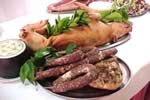 We
should not forget the many types of Sardinian cured meats. Pork is not
only used for roasting but also to produce an excellent variety of cold
cuts. There is a limited production of “capocollo”, a dry
cured salty pork meat made using the muscles on the neck, “pancetta” made
using the underside of the pig and cured in a way that is similar to that
of prosciutto, “prosciutto crudo” that comes from the upper
hind leg and shoulder of the pig and Sardinian sausage, once exclusively
homemade and now produced everywhere and available raw, cured or smoked.
It is made using lean pork meat cut into medium sized pieces mixed with
lard, salt, pepper, aniseed of fennel seeds, cloves and parsley. A real
delicacy, very popular with gourmets, is wild boar prosciutto.
We
should not forget the many types of Sardinian cured meats. Pork is not
only used for roasting but also to produce an excellent variety of cold
cuts. There is a limited production of “capocollo”, a dry
cured salty pork meat made using the muscles on the neck, “pancetta” made
using the underside of the pig and cured in a way that is similar to that
of prosciutto, “prosciutto crudo” that comes from the upper
hind leg and shoulder of the pig and Sardinian sausage, once exclusively
homemade and now produced everywhere and available raw, cured or smoked.
It is made using lean pork meat cut into medium sized pieces mixed with
lard, salt, pepper, aniseed of fennel seeds, cloves and parsley. A real
delicacy, very popular with gourmets, is wild boar prosciutto.up
Bread
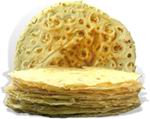 The
best known of Sardinian breads outside the island is Carasau bread, also called ‘musical
paper’ by foreigners. It has the appearance of wafer thin circular crispy
layers and it keeps very well for a long time. Shepherds were carrying it with
them during transhumance. If eaten with tomatoes and eggs it turns into a specialty
called Frattau bread and in the shops you can find the same type of bread seasoned
with oil and salt and it is called Guttiau bread. Another type of bread known
outside the island is “civraxiu”, a large round bread with a crisp
crust and soft interior. Especially good if accompanied by the juices of roast
suckling pig or roast lamb. Worth mentioning is also “su coccoi” which
in the Campidano area is made with fine flour or with semolina. A very popular
bread not only for its taste but also for its shape which changes from village
to village. There is also “su moddizzosu”, a circular and very
soft bread. It is particularly good with cheese and cured meats. Another type
of bread is “spianadas”, circular in shape, soft and easy to transport.
The
best known of Sardinian breads outside the island is Carasau bread, also called ‘musical
paper’ by foreigners. It has the appearance of wafer thin circular crispy
layers and it keeps very well for a long time. Shepherds were carrying it with
them during transhumance. If eaten with tomatoes and eggs it turns into a specialty
called Frattau bread and in the shops you can find the same type of bread seasoned
with oil and salt and it is called Guttiau bread. Another type of bread known
outside the island is “civraxiu”, a large round bread with a crisp
crust and soft interior. Especially good if accompanied by the juices of roast
suckling pig or roast lamb. Worth mentioning is also “su coccoi” which
in the Campidano area is made with fine flour or with semolina. A very popular
bread not only for its taste but also for its shape which changes from village
to village. There is also “su moddizzosu”, a circular and very
soft bread. It is particularly good with cheese and cured meats. Another type
of bread is “spianadas”, circular in shape, soft and easy to transport.up
First courses
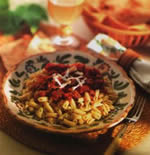 Before
we start telling you about first courses we should spend a few words on Sardinian
wheat which still has an excellent reputation both for its quality and its
flavor. It is used for the production of first rate quality pastas. Among the
best known Sardinian pastas are malloreddus, made using the best semolina and
warm water lightly salted and in the best Sardinian culinary tradition malloreddus
are flavored with saffron. They look like an empty shell and are characterized
by small rises obtained by rolling small pieces of pasta on the bottom of a
basket. A typical dish is Malloreddus Campidanese style with tomato sauce,
sausage cut in small pieces and abundant grated pecorino cheese. Fregula are
small handmade balls of pasta which are toasted in an oven. They are very good
in soup or seasoned with fresh sausage and tomato. A typical dish is called “Fregula
cun cocciuta” (fregola with clams). Pillus is a semi-fresh pasta similar
to “tagliolini” which is cooked in beef or sheep stock served on
a bed of fresh sheep's cheese. Panadas are savory cakes which, depending on
the area, are stuffed with meat or stewed eels, or even game (partridge, wild
boar or hare). And finally the “culurgiones ogliastrini”, unusual
little pouches made of pasta containing mashed potato, egg yolks, fresh pecorino
cheese, onion and fresh mint.
Before
we start telling you about first courses we should spend a few words on Sardinian
wheat which still has an excellent reputation both for its quality and its
flavor. It is used for the production of first rate quality pastas. Among the
best known Sardinian pastas are malloreddus, made using the best semolina and
warm water lightly salted and in the best Sardinian culinary tradition malloreddus
are flavored with saffron. They look like an empty shell and are characterized
by small rises obtained by rolling small pieces of pasta on the bottom of a
basket. A typical dish is Malloreddus Campidanese style with tomato sauce,
sausage cut in small pieces and abundant grated pecorino cheese. Fregula are
small handmade balls of pasta which are toasted in an oven. They are very good
in soup or seasoned with fresh sausage and tomato. A typical dish is called “Fregula
cun cocciuta” (fregola with clams). Pillus is a semi-fresh pasta similar
to “tagliolini” which is cooked in beef or sheep stock served on
a bed of fresh sheep's cheese. Panadas are savory cakes which, depending on
the area, are stuffed with meat or stewed eels, or even game (partridge, wild
boar or hare). And finally the “culurgiones ogliastrini”, unusual
little pouches made of pasta containing mashed potato, egg yolks, fresh pecorino
cheese, onion and fresh mint.up
Main courses
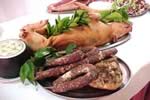 Ever-present
is the suckling pig which is roasted on a hand-crafted spit made of strawberry
tree wood seasoned only during cooking with salt, lard and fresh herbs such
as myrtle, rosemary, bay leaf and sage to give the meat inimitable flavor and
fragrance. The unique method of cooking completes the dish. It is worth mentioning
also two other ways of roasting. The first, which is called “mallori
de su sabatteri” comes from the Nuoro region and consists in introducing
animals one inside the other in the following way: you fill a calf with a goat
which in turn contains a suckling pig and so on, you keep on inserting an animal
into another like in Chinese boxes. The second way of roasting consists
of digging a hole in the ground where aromatic woods and myrtle leaves are
burning and burying a suckling pig or a wild boar. Then you cover the hole
with myrtle branches and hot embers. The meat is cooked very slowly by the
hot embers and becomes very aromatic. This way of roasting is called “carraxiu” in
Sardinian language. Among the various game dishes is “Is pillonis de
t'accula” which is a delicious dish made with thrushes and blackbirds.
The birds are boiled in salty water and wrapped in myrtle leaves for flavor.
Before we start talking about fish we must say that Sardinia, despite its abundance
in fish and seafood, does not have many original recipes because Sardinian
people were not fishermen by tradition. So seafood specialties are influenced
by other populations who arrived in Sardinia. Let us mention “burrida”,
a dish from Genoa subsequently transformed by Sardinian cuisine. This
dish consists of boiled dogfish covered with a sauce made combining oil, vinegar
and chopped walnuts. There is also “cassola”, a soup made using
a variety of fish, the delicious roast mullet and “scabecciu”,
which is mullet marinated in vinegar, and lobster with “vernaccia” in
which the noble lobster is enriched with cloves and delicate white wine.
Ever-present
is the suckling pig which is roasted on a hand-crafted spit made of strawberry
tree wood seasoned only during cooking with salt, lard and fresh herbs such
as myrtle, rosemary, bay leaf and sage to give the meat inimitable flavor and
fragrance. The unique method of cooking completes the dish. It is worth mentioning
also two other ways of roasting. The first, which is called “mallori
de su sabatteri” comes from the Nuoro region and consists in introducing
animals one inside the other in the following way: you fill a calf with a goat
which in turn contains a suckling pig and so on, you keep on inserting an animal
into another like in Chinese boxes. The second way of roasting consists
of digging a hole in the ground where aromatic woods and myrtle leaves are
burning and burying a suckling pig or a wild boar. Then you cover the hole
with myrtle branches and hot embers. The meat is cooked very slowly by the
hot embers and becomes very aromatic. This way of roasting is called “carraxiu” in
Sardinian language. Among the various game dishes is “Is pillonis de
t'accula” which is a delicious dish made with thrushes and blackbirds.
The birds are boiled in salty water and wrapped in myrtle leaves for flavor.
Before we start talking about fish we must say that Sardinia, despite its abundance
in fish and seafood, does not have many original recipes because Sardinian
people were not fishermen by tradition. So seafood specialties are influenced
by other populations who arrived in Sardinia. Let us mention “burrida”,
a dish from Genoa subsequently transformed by Sardinian cuisine. This
dish consists of boiled dogfish covered with a sauce made combining oil, vinegar
and chopped walnuts. There is also “cassola”, a soup made using
a variety of fish, the delicious roast mullet and “scabecciu”,
which is mullet marinated in vinegar, and lobster with “vernaccia” in
which the noble lobster is enriched with cloves and delicate white wine.up
Cheeses
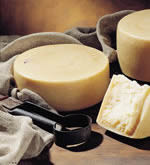 Sardinian
fresh sheep's cheese, Pecorino DOC, is surely one of the best known cheeses
in the world. It is made of sheep's milk and has the fragrance of grass. It
is cylindrical in shape and rarely weights more than 3 kg. Apart from being
an excellent table cheese it can also be grilled or grated. Roman Pecorino
DOC is originally a cheese from the area around Rome called Lazio but it has
been adopted by Sardinia. It is considered by everyone the king of sheep cheeses.
It is made using only whole milk from the sheep of Lazio and Sardinia. The
cylinders can be from 18 to 32 kg in weight. Aging time varies but it is never
less than 8 months; it is generally used for grating but it is excellent also
as a table cheese. Fiore Sardo DOC is another artisan cheese made following
an ancient Sardinian recipe. Its average weight is 3.5 kg and it is made using
exclusively fresh sheep's milk curdled with lamb or goat's rennet. There is
no doubt that with Fiore Sardo DOC Sardinia makes a unique and proud contribution
to the great cheeses of Italy. Worth a mention are also the canestrati cheeses
that are produced from whole sheep’s milk and molded in wicker baskets;
a wide range of fresh sheep cheeses made of full cream sheep's milk, natural
milk enzymes and liquid rennet; goat cheeses are made with full cream goat
milk and, according to hygienists and dieticians, are among the healthiest
cheeses. And finally we should remember the many types of ricotta cheese produced
in Sardinia, which are completely hand made by heating the whey that remains
after the production of sheep cheeses.
Sardinian
fresh sheep's cheese, Pecorino DOC, is surely one of the best known cheeses
in the world. It is made of sheep's milk and has the fragrance of grass. It
is cylindrical in shape and rarely weights more than 3 kg. Apart from being
an excellent table cheese it can also be grilled or grated. Roman Pecorino
DOC is originally a cheese from the area around Rome called Lazio but it has
been adopted by Sardinia. It is considered by everyone the king of sheep cheeses.
It is made using only whole milk from the sheep of Lazio and Sardinia. The
cylinders can be from 18 to 32 kg in weight. Aging time varies but it is never
less than 8 months; it is generally used for grating but it is excellent also
as a table cheese. Fiore Sardo DOC is another artisan cheese made following
an ancient Sardinian recipe. Its average weight is 3.5 kg and it is made using
exclusively fresh sheep's milk curdled with lamb or goat's rennet. There is
no doubt that with Fiore Sardo DOC Sardinia makes a unique and proud contribution
to the great cheeses of Italy. Worth a mention are also the canestrati cheeses
that are produced from whole sheep’s milk and molded in wicker baskets;
a wide range of fresh sheep cheeses made of full cream sheep's milk, natural
milk enzymes and liquid rennet; goat cheeses are made with full cream goat
milk and, according to hygienists and dieticians, are among the healthiest
cheeses. And finally we should remember the many types of ricotta cheese produced
in Sardinia, which are completely hand made by heating the whey that remains
after the production of sheep cheeses. up
Desserts
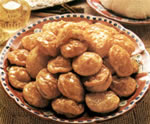 The
variety of Sardinian desserts uses almonds as their main ingredient. Chopped
almonds are indeed the main ingredient of the gattò, which contains
also sugar or honey and orange peel. There are culurgiones de mendula (almond
ravioli), typical pastries made in February for the Mardi Gras, copulettas,
a rustic version of meringues, amaretti (macaroons) and suspirus. On the most
solemn religious occasions such as All Saints' Day and All Souls' Day, typical
cakes such as pane'e sapa or pabassinas, made of concentrated must or sapa,
are prepared. Other well known Sardinian cakes are pirichittus, pistoccos,
mustazzoli and pardule. It is worthwhile mentioning the well known sebadas,
which are a typical Sardinian dessert made of cheese and honey. The same Sardinian
desserts have different names in different parts of the island.
The
variety of Sardinian desserts uses almonds as their main ingredient. Chopped
almonds are indeed the main ingredient of the gattò, which contains
also sugar or honey and orange peel. There are culurgiones de mendula (almond
ravioli), typical pastries made in February for the Mardi Gras, copulettas,
a rustic version of meringues, amaretti (macaroons) and suspirus. On the most
solemn religious occasions such as All Saints' Day and All Souls' Day, typical
cakes such as pane'e sapa or pabassinas, made of concentrated must or sapa,
are prepared. Other well known Sardinian cakes are pirichittus, pistoccos,
mustazzoli and pardule. It is worthwhile mentioning the well known sebadas,
which are a typical Sardinian dessert made of cheese and honey. The same Sardinian
desserts have different names in different parts of the island.up
Wine
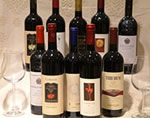 With
the introduction of new technologies both for growing vines and for wine production,
Sardinia made a jump ahead in the production and the marketing of its top wines.
Today’s wine industry offers a selection of high quality wines that compete
with the best of the European production. Privately owned wineries, with modern
small or medium cellars, have emerged next to the traditional wine cooperatives
and they boast modern production and marketing techniques. These wines are
balanced and smooth and yet they are easily recognizable during tastings for
their distinct flavor, they induce meditation and reflect the richness of the
soil where they come from.
With
the introduction of new technologies both for growing vines and for wine production,
Sardinia made a jump ahead in the production and the marketing of its top wines.
Today’s wine industry offers a selection of high quality wines that compete
with the best of the European production. Privately owned wineries, with modern
small or medium cellars, have emerged next to the traditional wine cooperatives
and they boast modern production and marketing techniques. These wines are
balanced and smooth and yet they are easily recognizable during tastings for
their distinct flavor, they induce meditation and reflect the richness of the
soil where they come from.up
Spirits
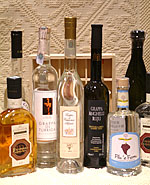 The “File
'e ferru” (distilled white spirit) is certainly the best known among
Sardinian spirits. It is made from selected marcs and it is a typical spirit
from Oristano and the inland.
The “File
'e ferru” (distilled white spirit) is certainly the best known among
Sardinian spirits. It is made from selected marcs and it is a typical spirit
from Oristano and the inland. It is interesting to know that the name "file'e ferru" derives from the piece of iron wire which was used to indicate where the spirit had been buried underground. In fact, at the turn of the last century it was produced illegally to avoid paying high taxes to the producers. It is worth mentioning another distilled spirit, the famous grappa. The aroma and taste of the grappa depends on the grapes from which it derives. Vernaccia, moscato, vermentino, cannonau and malvasia are all used to produce grappa and are widely available. Among the digestive liqueurs there is “mirto rosso” which is made from an infusion of myrtle berries in alcohol with honey or sugar added. "Mirto bianco" is a delicate liqueur made by infusing the flower buds from the myrtle in alcohol. It has a more delicate taste and a light green color. There are also “Limonello” and “Ficodindia” liqueurs which are obtained by infusion in alcohol, with sugar or honey added respectively to lemon peel for limonello and ripe prickly pears for the ficodindia. Another typical production is the Villacidro liqueur, made using a secret ancient recipe. There are two types of "Villacidro": white and yellow. The yellow type is made by adding saffron, now grown in Sardinia despite its eastern origin.
up

 Costa Paradiso - Sardinia
Costa Paradiso - Sardinia Costa Paradiso - Sardinia
Costa Paradiso - Sardinia Costa Paradiso - Sardinia
Costa Paradiso - Sardinia Costa Paradiso - Sardinia
Costa Paradiso - Sardinia Costa Paradiso - Sardinia
Costa Paradiso - Sardinia Costa Paradiso - Sardinia
Costa Paradiso - Sardinia